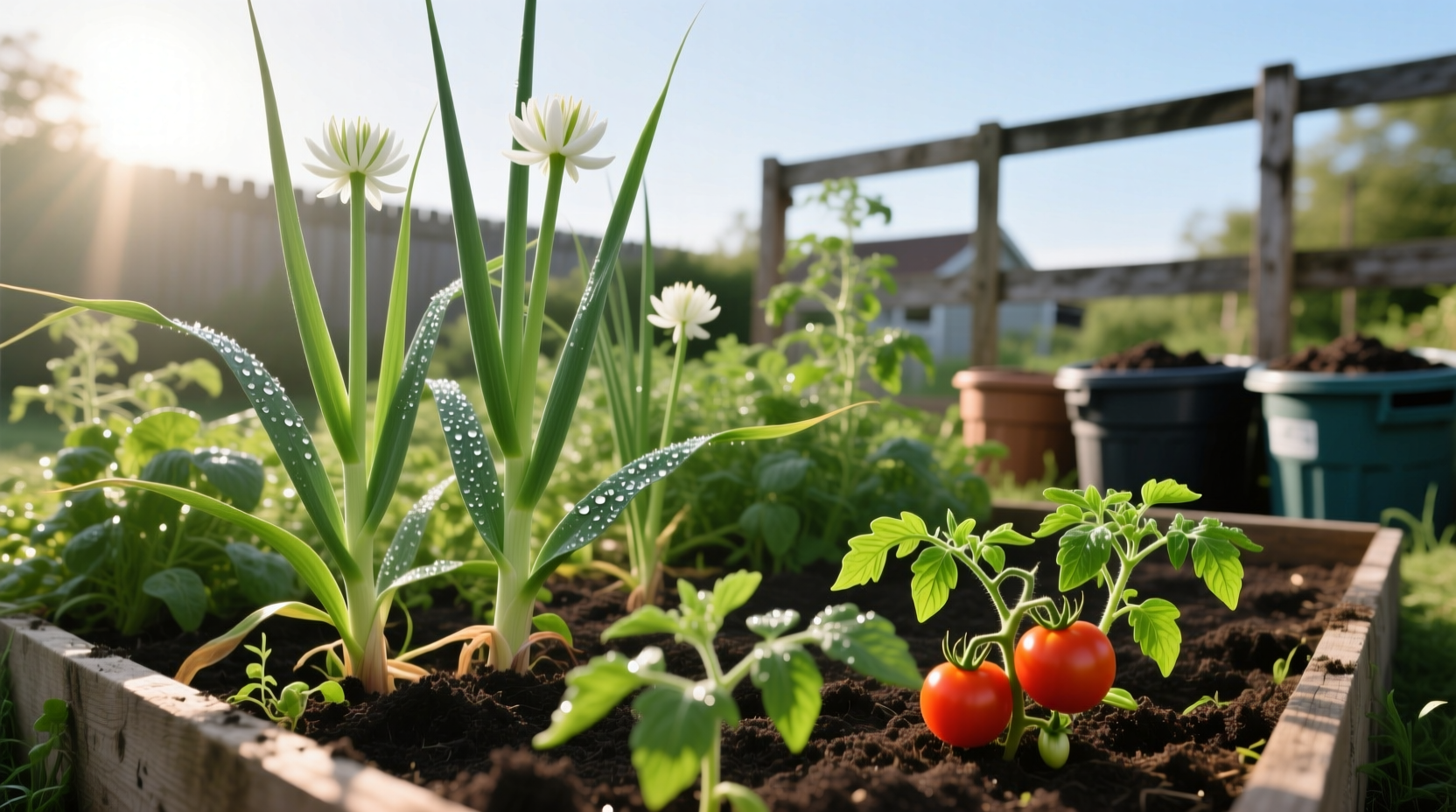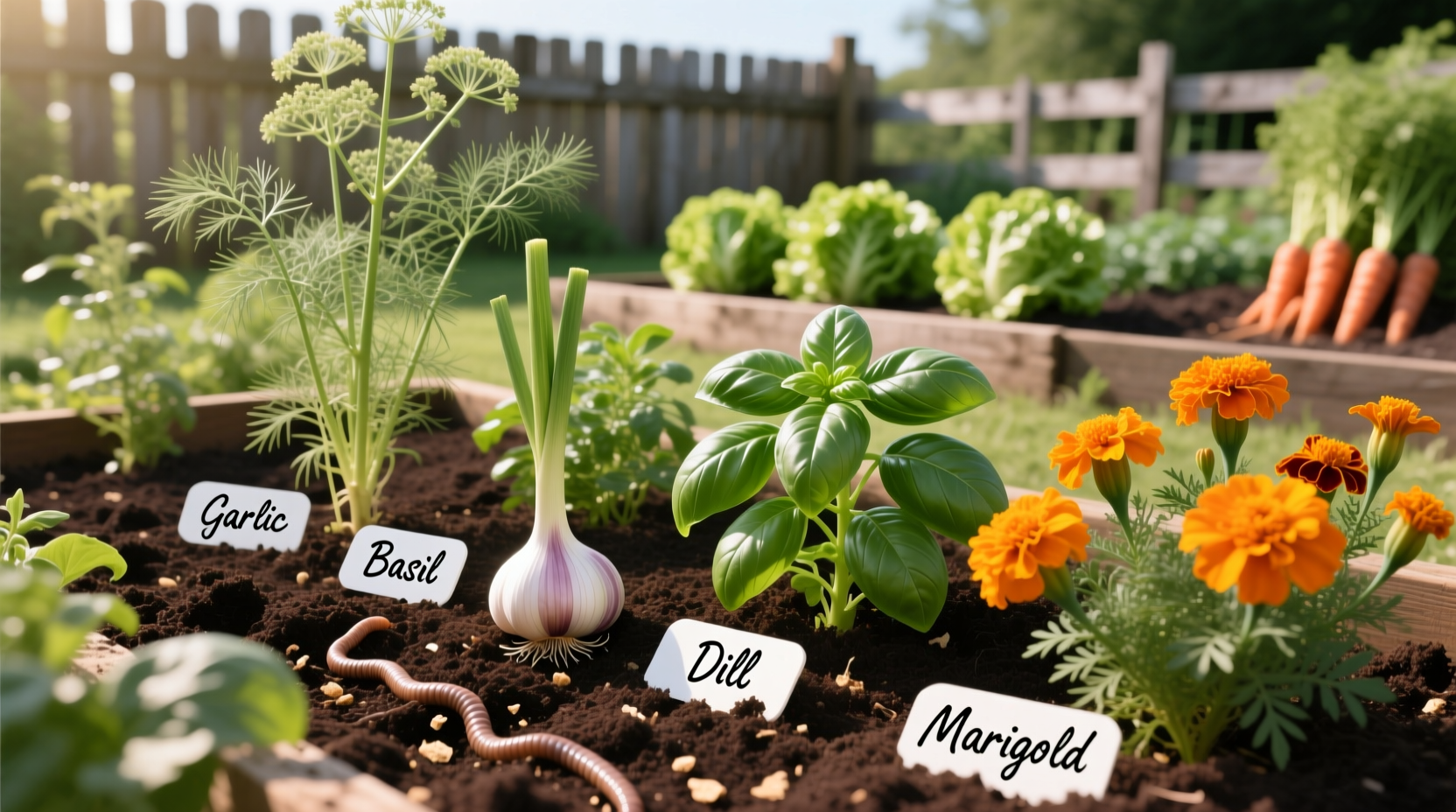Discover how strategic companion planting with garlic can transform your garden's health and productivity. This guide reveals scientifically-backed plant pairings that leverage garlic's natural pest-repelling properties while avoiding combinations that hinder growth. You'll learn exactly which vegetables, flowers, and fruit trees benefit from garlic's presence, plus practical implementation tips for maximizing your garden's potential without chemical pesticides.
Why Garlic Makes an Ideal Companion Plant
Garlic's effectiveness in companion planting stems from its sulfur-containing compounds, particularly allicin, which deters numerous garden pests while providing subtle soil benefits. When garlic roots release these compounds into the soil, they create a protective zone that repels insects without harming beneficial pollinators. Research from Cornell University's College of Agriculture and Life Sciences confirms that alliums like garlic disrupt pest feeding patterns through their strong volatile compounds, reducing the need for chemical interventions.
| Plant Type | Benefit from Garlic | Scientific Mechanism |
|---|---|---|
| Tomatoes | Reduces spider mites and aphids by 40-60% | Allicin disrupts insect feeding behavior |
| Roses | Prevents black spot and aphid infestations | Sulfur compounds create unfavorable environment |
| Carrots | Deters carrot fly by masking scent | Strong garlic odor confuses pest navigation |
| Fruit Trees | Reduces codling moth and apple scab | Creates pest-repelling microclimate |
Top 7 Plants That Thrive When Grown with Garlic
1. Tomatoes: The Pest-Repelling Powerhouse
Interplanting garlic between tomato rows creates a natural defense system against spider mites and aphids. The University of California's Integrated Pest Management Program recommends planting garlic cloves 12-18 inches from tomato plants for optimal protection. This pairing works particularly well in raised beds where soil drainage supports both plants' root systems. For best results, plant garlic in fall for spring harvest alongside your tomato seedlings.
2. Roses: Beauty Protected Naturally
Gardeners have paired garlic with roses for centuries to prevent black spot and deter aphids. Plant garlic bulbs around the drip line of rose bushes (where rain falls from the outermost leaves) to create an invisible protective barrier. The Royal Horticultural Society's trials show this combination reduces fungal infections by creating microclimates with slightly elevated sulfur levels that pathogens avoid. Space garlic cloves 6-8 inches from rose canes for maximum benefit without root competition.
3. Fruit Trees: Orchard Guardian
Planting garlic around fruit trees creates a natural pest deterrent zone. Washington State University Extension research demonstrates that a 2-foot ring of garlic planted around young fruit trees reduces codling moth infestations by disrupting their mating cycles. For established trees, plant garlic at the drip line where fallen leaves create natural mulch. This technique works exceptionally well for apple, pear, and stone fruit trees while improving soil microbial activity.
4. Carrots: The Scent-Masking Strategy
Carrot flies rely on scent to locate host plants, and garlic's strong odor effectively masks carrot aroma. Oregon State University's horticulture department recommends alternating rows of carrots and garlic for optimal protection. Plant garlic cloves 4-6 inches apart with carrots sown in between. This arrangement works best when garlic is planted first, allowing its scent profile to establish before carrots emerge.
5. Leafy Greens: Pest-Free Harvests
Garlic's presence significantly reduces aphid populations on lettuce, spinach, and kale. The strong scent confuses pests searching for host plants while creating an environment they find unappealing. For raised bed gardens, plant garlic at bed corners with greens filling the center. This arrangement provides protection while maximizing space. Remember to harvest garlic scapes (flower stalks) to prevent the plant from diverting energy from bulb development.
6. Beets: Flavor Enhancement Pairing
While not as commonly discussed, beets benefit from garlic's presence through improved soil conditions and pest protection. The sulfur compounds released by garlic roots enhance beet's natural sweetness while deterring leaf miners. Space garlic cloves 8-10 inches from beet seeds for optimal growth without root competition. This pairing works particularly well in cooler climates where both plants thrive.
7. Strawberries: Disease Prevention Duo
Garlic planted at strawberry bed perimeters reduces gray mold and repels tarnished plant bugs. The University of Maine's Cooperative Extension reports that this combination decreases fungal infections by creating microclimates with slightly elevated sulfur levels. Plant garlic cloves 6 inches apart around strawberry beds, taking care not to overcrowd the strawberry runners. This arrangement provides protection while allowing strawberries adequate space to spread.
Plants to Avoid Growing Near Garlic
Understanding which plants don't pair well with garlic is equally important for garden success. Garlic's sulfur compounds can inhibit growth in certain plant families through allelopathic effects.
Legumes: The Nitrogen-Fixing Conflict
Beans, peas, and other legumes should never be planted near garlic. Research from the Rodale Institute shows that garlic's sulfur compounds interfere with rhizobia bacteria responsible for nitrogen fixation in legume roots. This disruption can reduce legume yields by up to 30% while providing no reciprocal benefits. Maintain at least 18-24 inches between garlic and legume plantings to prevent this negative interaction.
Asparagus: Growth Inhibition
Garlic can stunt asparagus growth when planted in close proximity. Cornell University's studies indicate that alliums release compounds that suppress asparagus spear development during the critical spring emergence period. If growing both in your garden, separate them by at least 3 feet or use physical barriers like landscape fabric to prevent root interaction.
Implementing Garlic Companion Planting: Practical Strategies
Seasonal Timing Considerations
Successful companion planting with garlic requires attention to seasonal timing. In most climates, plant garlic cloves in fall (October-November) for spring harvest. This timing allows garlic to establish roots before winter while providing early-season pest protection for spring-planted crops. For warmer climates (zones 8-10), plant garlic in late winter for early summer harvest. Always rotate garlic planting locations annually to prevent soil-borne disease buildup.
Spacing Guidelines for Maximum Benefit
Proper spacing ensures both garlic and companion plants receive adequate resources. Follow these spacing recommendations:
- Tomatoes: 12-18 inches between garlic and tomato plants
- Roses: 6-8 inches from rose canes
- Carrots: Alternate rows with 4-6 inches between plants
- Fruit Trees: Plant at drip line, 12-18 inches apart
- Leafy Greens: Garlic at bed corners, 12 inches from greens
Avoiding Common Implementation Mistakes
Gardeners often make these errors when implementing garlic companion planting:
- Overcrowding plants, leading to resource competition
- Planting garlic too close to incompatible species
- Forgetting to rotate garlic planting locations annually
- Allowing garlic to flower, which reduces bulb development
- Planting garlic in poorly drained soil, causing bulb rot
Remember that companion planting works best as part of an integrated approach that includes proper soil preparation, appropriate watering, and regular monitoring for pest issues.

When Garlic Companion Planting Might Not Work
While generally effective, garlic companion planting has limitations. In extremely sandy soils with poor water retention, garlic's pest-repelling compounds may wash away too quickly to provide consistent protection. Similarly, during periods of heavy rainfall, the compounds can become diluted. Gardens with severe pest infestations may require additional interventions beyond companion planting. The effectiveness also varies by garlic variety—hardneck varieties typically produce stronger pest-repelling compounds than softneck types.
Maximizing Your Garden's Potential
By strategically incorporating garlic into your planting plan, you create a more resilient garden ecosystem that requires fewer interventions. Start with one or two companion pairings this season, observe the results, and gradually expand your companion planting strategy. Remember that healthy soil forms the foundation of successful companion planting—incorporate compost and organic matter to support both garlic and its companion plants. With proper implementation, you'll enjoy healthier plants, reduced pest pressure, and potentially increased yields throughout your garden.











 浙公网安备
33010002000092号
浙公网安备
33010002000092号 浙B2-20120091-4
浙B2-20120091-4